1997 TOYOTA RAV4 tires
[x] Cancel search: tiresPage 79 of 198
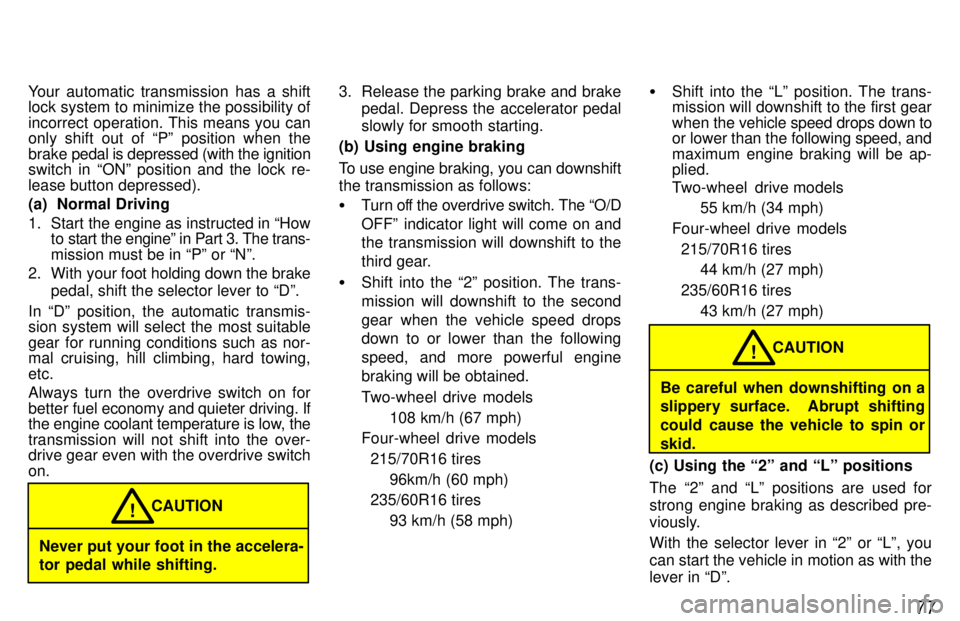
77
Your automatic transmission has a shift
lock system to minimize the possibility of
incorrect operation. This means you can
only shift out of Pº position when the brake
pedal is depressed (with the ignition
switch in ONº position and the lock re-
lease button depressed). (a) Normal Driving
1. Start the engine as instructed in How to start the engineº in Part 3. The trans- mission must be in Pº or Nº.
2. With your foot holding down the brake pedal, shift the selector lever to Dº.
In Dº position, the automatic transmis-
sion system will select the most suitable
gear for running conditions such as nor-
mal cruising, hill climbing, hard towing, etc.
Always turn the overdrive switch on for
better fuel economy and quieter driving. If
the engine coolant temperature is low, thetransmission will not shift into the over-
drive gear even with the overdrive switch on.
Never put your foot in the accelera- tor pedal while shifting. CAUTION
! 3. Release the parking brake and brake
pedal. Depress the accelerator pedal
slowly for smooth starting.
(b) Using engine braking
To use engine braking, you can downshift the transmission as follows: � Turn off the overdrive switch. The O/D
OFFº indicator light will come on and the transmission will downshift to the
third gear.
� Shift into the 2º position. The trans-
mission will downshift to the second
gear when the vehicle speed drops down to or lower than the following speed, and more powerful engine
braking will be obtained.
Two-wheel drive models
108 km/h (67 mph)
Four-wheel drive models 215/70R16 tires
96km/h (60 mph)
235/60R16 tires
93 km/h (58 mph) �
Shift into the Lº position. The trans- mission will downshift to the first gear
when the vehicle speed drops down to
or lower than the following speed, and
maximum engine braking will be ap- plied.
Two-wheel drive models
55 km/h (34 mph)
Four-wheel drive models 215/70R16 tires 44 km/h (27 mph)
235/60R16 tires 43 km/h (27 mph)
Be careful when downshifting on a
slippery surface. Abrupt shifting
could cause the vehicle to spin orskid. CAUTION
!
(c) Using the 2º and Lº positions
The 2º and Lº positions are used for
strong engine braking as described pre-
viously. With the selector lever in 2º or Lº, you
can start the vehicle in motion as with the
lever in Dº.
Page 80 of 198

78With the selector lever in 2º, the vehicle
will
start in the first gear and automatically
shift to the second gear.
With the selector lever in Lº, the trans-
mission is engaged in the first gear.
NOTICE
�Be careful not to overrev the en-
gine. Watch the tachometer to
keep engine rpm from going intothe red zone. The approximatemaximum allowable speed for
each position is given below foryour reference:Two-wheel drive models
2º 130 km/h (80 mph). . . . . .
Lº 72 km/h (44 mph) . . . . .
Four-wheel drive models
215/70R16 tires 2º 121 km/h (75 mph). . . . . .
Lº 67 km/h (41 mph) . . . . .
235/60R16 tires 2º 188 km/h (73 mph). . . . . .
Lº 65 km/h (40 mph) . . . . .
�Do not continue hill climbing or
hard towing for a long time in the
2º or Lº position. This may
cause severe automatic transmis-sion damage from overheating.
To prevent such damage, Dºposition should be used in hillclimbing or hard towing.
(d) Backing up
1. Bring the vehicle to a complete stop.
2. With the brake pedal held down with your foot, shift the selector lever to the
Rº position.
NOTICE
Never shift into reverse while the vehicle is moving.
(e) Parking
1. Bring the vehicle to a complete stop.
2. Pull the parking brake lever up fully to securely apply the parking brake.
3. With the brake pedal pressed down, shift the selector lever to the Pº posi- tion.
While the vehicle is moving, never
attempt to move the selector lever
into Pº position under any circum-
stances. Serious mechanical dam-
age and loss of vehicle control mayresult. CAUTION
!
(f) Good driving practice � If the transmission is repeatedly up-
shifted and downshifted between third
gear and overdrive when climbing a
gentle slope, the overdrive switch
should be turned off. Be sure to turn the switch on immediately afterward.
� When towing a trailer, in order to main-
tain engine braking efficiency, do notuse overdrive.
Always keep your foot on the brake
pedal while stopped with the engine
running. This prevents the vehicle
from creeping. CAUTION
!
Page 82 of 198

80
The shift pattern is as shown above.
Press the clutch pedal down fully while
shifting, and then release it slowly. Do not
rest your foot on the pedal while driving, because it will cause clutch trouble. And do not use the clutch to hold the vehicle
when stopped on an uphill grade-use the
parking brake. Recommended shifting speeds
The transmission is fully synchronized
and upshifting or downshifting is easy.
For the best compromise between fuel
economy and vehicle performance, you
should upshift or downshift at the follow-
ing speeds: gear km/h (mph)
1 to 2 or 2 to 1 24 (15)
2 to 3 or 3 to 2 41 (25)
3 to 4 or 4 to 3 65 (40)
4 to 5 or 5 to 4 72 (45)
Downshift to the appropriate gear if accel-
eration is needed when you are cruising
below the above downshifting speeds.
Upshifting too soon or downshifting too late will cause lugging and, possibly, ping-
ing. Regularly revving the engine to maxi-
mum speed in each gear will cause exces-sive engine wear and high fuel consump- tion.
Maximum allowable speeds
To get on a highway or to pass slower traf- fic, maximum acceleration may be neces-
sary. Make sure you observe the following
maximum allowable speeds in each gear:
Two-wheel drive models
gear km/h (mph)
1 47 (29)
2 95 (59)
3 144 (89)
4 198 (114) Four-wheel drive models 215/60R16 tires
gear km/h (mph)
1 44 (27)
2 88 (53)
3 133 (83)
4 183 (114)
235/60R16 tires
gear km/h (mph)
1 43 (26)
2 86 (53)
3 121 (75)
4 165 (102)
NOTICE
Do not downshift if you are going faster than the maximum allowable
speed for the next lower gear.
Good driving practice � If it is difficult to shift into reverse, put
the transmission in neutral, release
the clutch pedal momentarily, and then
try again.
Manual transmission
Page 108 of 198
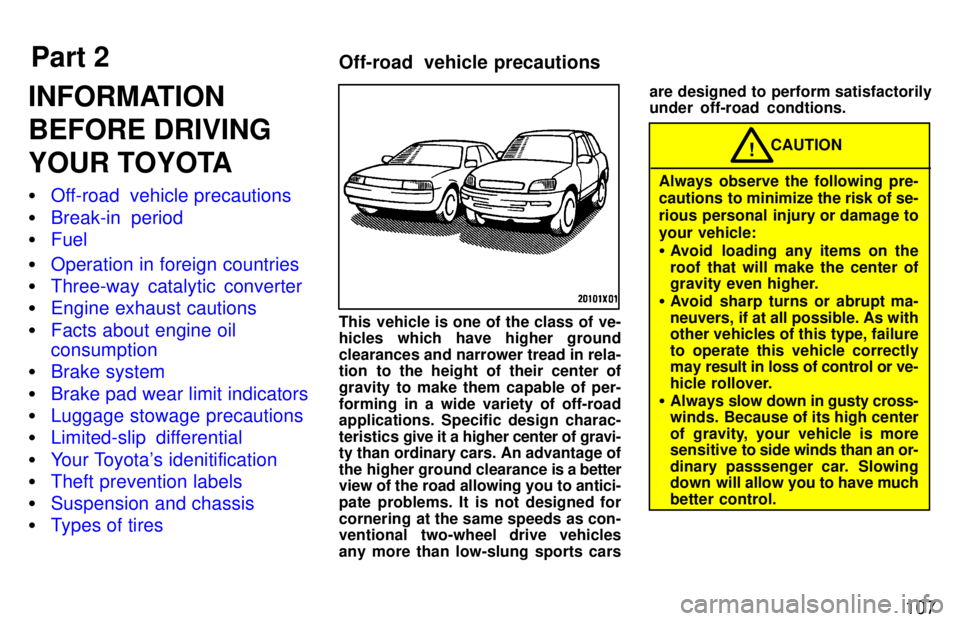
Part 2Off-road vehicle precautions
107
INFORMATION
BEFORE DRIVING
YOUR TOYOTA �
Off-road vehicle precautions
�Break-in period
�Fuel
�Operation in foreign countries
�Three-way catalytic converter
�Engine exhaust cautions
�Facts about engine oil consumption
�Brake system
�Brake pad wear limit indicators
�Luggage stowage precautions
�Limited-slip differential
�Your Toyota's idenitification
�Theft prevention labels
�Suspension and chassis
�Types of tires
This vehicle is one of the class of ve-
hicles which have higher ground
clearances and narrower tread in rela-
tion to the height of their center of
gravity to make them capable of per-forming in a wide variety of off-road applications. Specific design charac-
teristics
give it a higher center of gravi-
ty than ordinary cars. An advantage of
the higher ground clearance is a better
view of the road allowing you to antici-
pate problems. It is not designed for
cornering at the same speeds as con-
ventional two-wheel drive vehicles
any more than low-slung sports cars are designed to perform satisfactorily under off-road condtions.
CAUTION!
Always observe the following pre-
cautions to minimize the risk of se-
rious personal injury or damage toyour vehicle: � Avoid loading any items on the
roof that will make the center of
gravity even higher.
� Avoid sharp turns or abrupt ma-
neuvers, if at all possible. As with
other vehicles of this type, failure
to operate this vehicle correctly
may result in loss of control or ve-
hicle rollover.
� Always slow down in gusty cross-
winds. Because of its high center
of gravity, your vehicle is more
sensitive to side winds than an or-
dinary passsenger car. Slowing
down will allow you to have much
better control.
Page 115 of 198
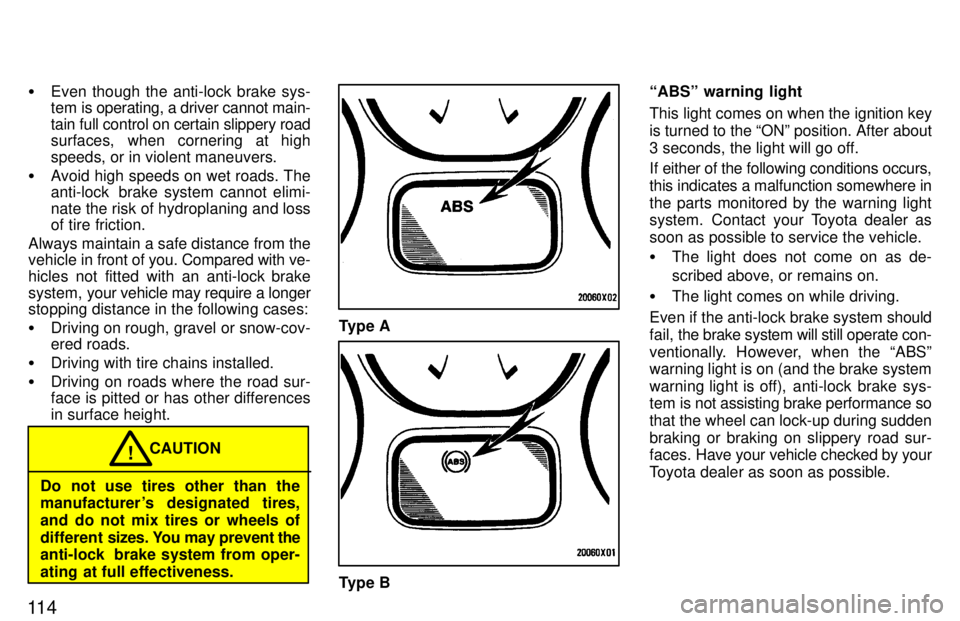
11 4�
Even though the anti-lock brake sys-
tem is operating, a driver cannot main- tain full control on certain slippery road
surfaces, when cornering at high speeds, or in violent maneuvers.
� Avoid high speeds on wet roads. The
anti-lock brake system cannot elimi-
nate the risk of hydroplaning and loss of tire friction.
Always maintain a safe distance from the
vehicle in front of you. Compared with ve-
hicles not fitted with an anti-lock brake
system, your vehicle may require a longer
stopping distance in the following cases: � Driving on rough, gravel or snow-cov-
ered roads.
� Driving with tire chains installed.
� Driving on roads where the road sur-
face is pitted or has other differences in surface height.
CAUTION!
Do not use tires other than the
manufacturer 's designated tires,
and do not mix tires or wheels of
different si zes. You may prevent the
anti-lock brake system from oper-
ating at full effectiveness.
Type A
Type B ABSº warning light
This light comes on when the ignition key is turned to the ONº position. After about
3 seconds, the light will go off.
If either of the following conditions occurs, this indicates a malfunction somewhere inthe parts monitored by the warning light
system. Contact your Toyota dealer as
soon as possible to service the vehicle. �
The light does not come on as de-
scribed above, or remains on.
� The light comes on while driving.
Even if the anti-lock brake system should
fail, the brake system will still operate con-
ventionally. However, when the ABSº
warning light is on (and the brake system
warning light is off), anti-lock brake sys-
tem is not assisting brake performance so that the wheel can lock-up during sudden
braking or braking on slippery road sur-
faces. Have your vehicle checked by your
Toyota dealer as soon as possible.
Page 117 of 198
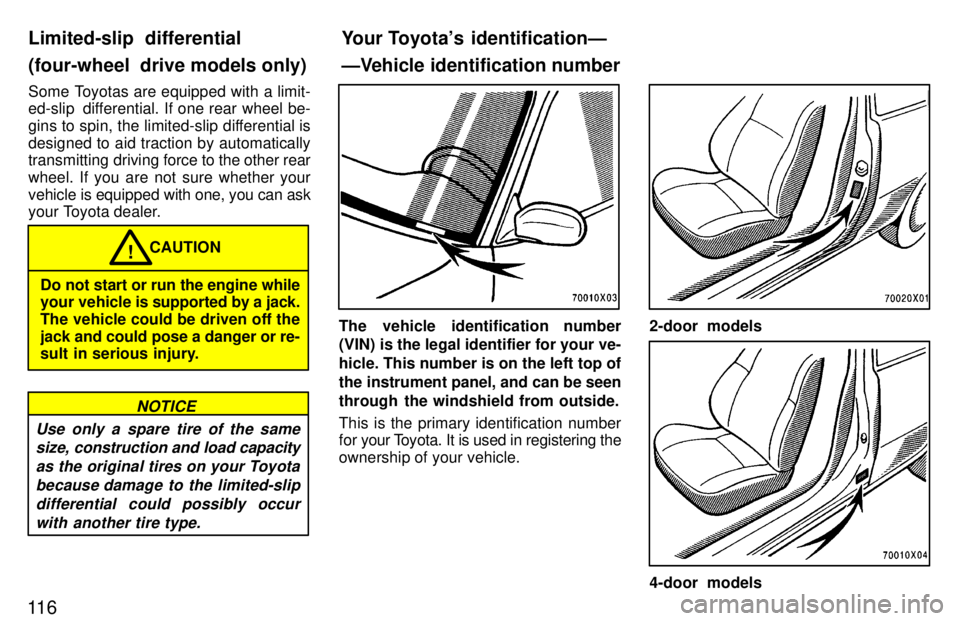
11 6Some Toyotas are equipped with a limit-
ed-slip differential. If one rear wheel be-
gins to spin, the limited-slip differential is
designed to aid traction by automatically
transmitting driving force to the other rear
wheel. If you are not sure whether your
vehicle is equipped
with one, you can ask
your Toyota dealer.
CAUTION!
Do not start or run the engine while
your vehicle is supported by a jack.
The vehicle could be driven off the jack and could pose a danger or re-
sult in serious injury.
Use only a spare tire of the same
size, construction and load capacity
as the original tires on your Toyota because damage to the limited-slip differential could possibly occurwith another tire type.
NOTICE
The vehicle identification number
(VIN) is the legal identifier for your ve- hicle. This number is on the left top of
the instrument panel, and can be seen
through the windshield from outside.
This is the primary identification number
for your T oyota. It is used in registering the
ownership of your vehicle.2-door models
4-door models
Limited-slip differential
(four-wheel drive models only)
Your Toyota's identificationÐ
ÐVehicle identification number
Page 119 of 198

11 8
CAUTION!
Do not modify the suspension/
chassis with lift kits, spacers,
springs, etc. It can cause danger-
ous handling characteristics, re-
sulting in loss of control. Determine what kind of tires your ve-
hicle is originally equipped with.
1. Summer tires
Summer tires are high-speed capability
tires best suited to highway driving under dry conditions. Since
summer tires do not have the same
traction performance as snow tires, sum-
mer tires are inadequate for driving on
snow-covered or icy roads. For driving on
snow-covered or icy roads, we recom-
mend using snow tires. If installing snow tires, be sure to replace all four tires.
2. All season tires
All season tires are designed to provide
better traction in snow and to be adequate
for driving in most winter conditions, as
well as for use all year round.
All season tires, however, do not have ad-
equate traction performance compared
with snow tires in heavy or loose snow.
Also, all season tires fall short in accelera-
tion and handling performance compared with summer tires in highway driving.CAUTION!
� Do not mix summer and all sea-
son tires on your vehicle as this
can cause dangerous handling
characteristics, resulting in loss
of control.
� Do not use tire other than the
manufacturer 's designated tires,
and never mix tires or wheels of
the sizes different from the origi- nals.
Suspension and chassis Types of tires
Page 122 of 198
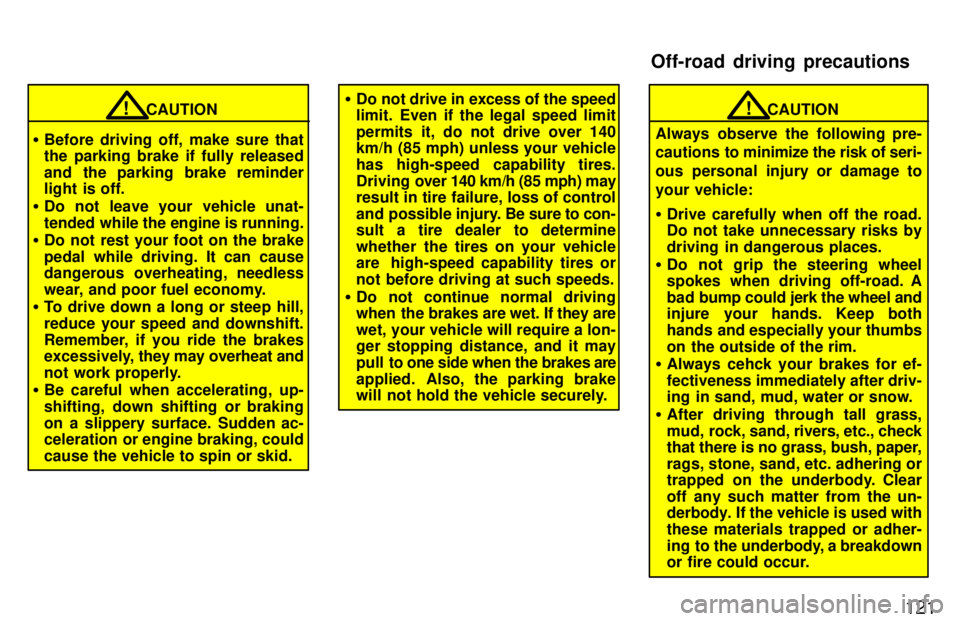
121
CAUTION!
� Before driving off, make sure that the parking brake if fully released
and the parking brake reminder
light is off.
� Do not leave your vehicle unat-
tended while the engine is running.
� Do not rest your foot on the brake
pedal while driving. It can cause
dangerous overheating, needless
wear, and poor fuel economy.
� To drive down a long or steep hill,reduce your speed and downshift.
Remember, if you ride the brakes
excessively, they may overheat and
not work properly.
� Be careful when accelerating, up-
shifting, down shifting or braking
on a slippery surface. Sudden ac-
celeration or engine braking, could cause the vehicle to spin or skid.�Do not drive in excess of the speed
limit. Even if the legal speed limit
permits it, do not drive over 140
km/h (85 mph) unless your vehicle
has high-speed capability tires.
Driving over 140 km/h (85 mph) may
result in tire failure, loss of control
and possible injury. Be sure to con-
sult a tire dealer to determine
whether the tires on your vehicle
are high-speed capability tires or
not before driving at such speeds.
� Do not continue normal driving
when the brakes are wet. If they are
wet, your vehicle will require a lon-ger stopping distance, and it may
pull to one side when the brakes are
applied. Also, the parking brake
will not hold the vehicle securely.CAUTION!
Always observe the following pre-
cautions to minimize the risk of seri-
ous personal injury or damage to
your vehicle: � Drive carefully when off the road. Do not take unnecessary risks by
driving in dangerous places.
� Do not grip the steering wheel
spokes when driving off-road. A
bad bump could jerk the wheel and
injure your hands. Keep both
hands and especially your thumbs
on the outside of the rim.
� Always cehck your brakes for ef-fectiveness immediately after driv-
ing in sand, mud, water or snow.
� After driving through tall grass,
mud, rock, sand, rivers, etc., check
that there is no grass, bush, paper,
rags, stone, sand, etc. adhering or
trapped on the underbody. Clear
off any such matter from the un-
derbody. If the vehicle is used with these materials trapped or adher-
ing to the underbody, a breakdown
or fire could occur.
Off-road driving precautions